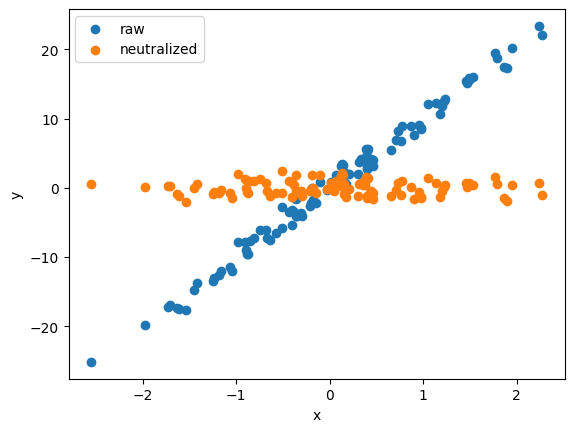Feature Neutralization#
feature neutralization(factor neutralization)はKaggleやNumeraiで使われる特徴量の変換手法
feature neutralizationはneutralにしたい変数を、ターゲットに対して直交化して置き換える処理をしています。
import pandas as pd
import numpy as np
def neutralize_series(series, by, proportion=1.0):
scores = series.values.reshape(-1, 1)
exposures = by.values.reshape(-1, 1)
# this line makes series neutral to a constant column so that it's centered and for sure gets corr 0 with exposures
exposures = np.hstack(
(exposures, np.array([np.mean(series)] * len(exposures)).reshape(-1, 1))
)
correction = proportion * (exposures.dot(np.linalg.lstsq(exposures, scores)[0]))
corrected_scores = scores - correction
neutralized = pd.Series(corrected_scores.ravel(), index=series.index)
return neutralized
import matplotlib.pyplot as plt
n = 100
np.random.seed(0)
x = np.random.normal(size=n)
y = 10 * x + np.random.normal(size=n)
y_ = neutralize_series(pd.Series(y), pd.Series(x), proportion=1.0)
fig, ax = plt.subplots()
ax.scatter(x, y, label="raw")
ax.scatter(x, y_, label="neutralized")
ax.set(xlabel="x", ylabel="y")
ax.legend()
fig.show()
/tmp/ipykernel_7605/527208119.py:13: FutureWarning: `rcond` parameter will change to the default of machine precision times ``max(M, N)`` where M and N are the input matrix dimensions.
To use the future default and silence this warning we advise to pass `rcond=None`, to keep using the old, explicitly pass `rcond=-1`.
correction = proportion * (exposures.dot(np.linalg.lstsq(exposures, scores)[0]))
